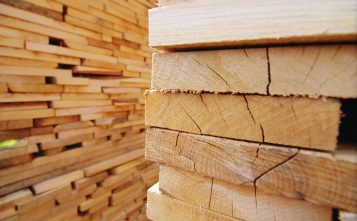The national report on the Dutch timber market issued in advance of the 77th session of the ECE Committee on Forests and the Forest Industry (COFFI), due to be held from 4 to 7 November 2019 in Geneva, Switzerland, highlights continuing potential for market growth in the Netherlands, in contrast to other European countries where market conditions appear to be deteriorating.
According to CPB (Netherlands Bureau for Economic Policy Analysis), the Dutch economy will grow by 1.8% in 2019 and 1.5% in 2020. Although the uncertainty created by external issues such as US trade policy and Brexit has undermined confidence, business investment growth has been robust so far this year and the disposable income of Dutch households continues to increase on the back of tax cuts, rising wages and high levels of employment.
At 3.3% of the work force, the level unemployment in the Netherlands is now lower than before the financial crisis and amongst the lowest in the EU.
After the sharp 40% decline in house completions between 2008 and 2012, residential construction has been recovering due to low mortgage rates and government stimulus measures. House completions in 2018 were 6% up on the previous year.
The number of residential building permits continued to rise in the Netherlands in 2018, although at a slower rate than in 2017 due to lack of available land for new construction and the constrained capacity of municipalities and private developers. Building contractors are suffering from a lack of skilled workers while projects are being delayed by shortages in the supply of concrete. This year housing completions are expected to be slightly down on last year.
While the pace of new housing construction is slowing slightly, there is still strong activity in the Netherlands timber industry in 2019, particularly in sectors involved in finishing and remodelling activities, such as joinery and furniture. According to Statistics Netherlands, total timber industry turnover increased in the second quarter of 2019 by 9.0% compared to the same quarter of 2018. Dutch timber companies also anticipate profitability to be enhanced by declining material prices on the back of the slowing global economy.
According to the COFFI report, the positive market prospects in the Netherlands extend to tropical products, for which consumption is benefitting from strong construction activity and from associated good demand for joinery, garden decking and furniture products.
However, the report also cautions that consumption levels were insufficient to absorb larger tropical wood import levels in 2018, leading to a build-up in stocks. Demand for tropical timber for water protection works, a particularly significant market in a country with large areas reclaimed from the sea, has remained more consistent than the construction sector over the long term.
The sector suffered less during the financial crises, propped up by government investment, and has grown only slowly since.
There is also some expectation that timber might benefit in other sectors from increased environmental awareness amongst consumers and architects. Although competition with other building materials is intense, there are indications that timber is recovering some market share.
For example, there are signs of wood being preferred over PVC plastic in renovation projects.
Concerted efforts to reinforce this trend in the Netherlands are being made by private sector timber promotion activities led by Centrum Hout, a collaboration between the Netherland Timber Trade Association (NTTA) and Dutch Timber Industry Association (NBvT).
Centrum Hout has developed campaigns targeting specific end use applications. For example, one plan which aims to increase use of certified tropical timber in water protection works is supported by 12 companies. All are provided with detailed technical and environmental guidance.
Communication activity is also targeted at the most influential decision makers in the specification and procurement process. Civil engineers have been identified as a particularly crucial target group and there is a strong focus on direct contact with the largest engineering firms to identify their concerns and the information they need.
Centrum Hout has also commissioned work on life cycle assessment (LCA) and full life cycle costing studies to assess the relative environmental impact and costs of using different materials on a cradle to grave basis Netherlands proactive support for green supply chains Alongside this promotion work, the Dutch timber trade and industry has taken a proactive approach to develop the green supply chain, setting ambitious sustainability criteria for all members of the Netherlands Timber Trade Association (VVNH) that together account for 80% of tropical timber imports. Through development and communication of this policy, the trade is recognised by government and NGOs as a credible partner.
According to the latest annual trade report issued by VVNH, association members have already achieved their original target that 90% of wood traded be certified by either FSC or PEFC by 2020. However, this target has been met primarily through Netherlands heavy reliance on softwoods and sheet materials from supply regions, particularly in Europe, where there is widespread availability of certified wood.
The trade report, which covers VVNH’s 216 members and was prepared by the consultancy firm Probos, indicates that 91.9% of the 1.8 million m3 of softwood, hardwood and sheet materials imported by VVNH companies in 2018 was backed with an FSC or PEFC certificate, about the same level as 2017.
The highest proportion of certified imports came in softwood, up from 98.4% in 2017 to 99.1%. Certified sheet materials showed an increase in the certified total from 93.5% to 94.5%, while certified temperate hardwood imports were up from 46.6% to 59.6%. But the proportion of certified tropical timber imported into the Netherlands fell from 66.1% in 2017 to 63.6% last year.
VVNH Director Paul van den Heuvel said that there were various factors involved in this decline. “Members earlier reported that it was becoming increasingly difficult to get verified sustainable tropical wood. Now this is also reflected in the figures,” he said. “Among the causes is that some certified forest concessions are in conflict areas, making them no longer accessible. Also implicated is increasing tropical timber demand in Asia, where sustainability is hardly ever a purchasing criterion.”
In addition, Jan Oldenburger from Probos added; ‘Malaysia is the most important supplier of certified material for the Dutch market and if the certified sustainably managed forest area there decreases, it will impact the market share.”
In the Netherlands, leading timber and associated trade associations, construction and retail sector bodies, unions, conservation organisations and various government ministries have signed a ‘Covenant’ to make “verified sustainable” the norm across the supply chain.
Mr Van den Heuvel, chairman of the Covenant board, said the VVNH and the other 23 signatories needed to step up their efforts in supporting sustainable tropical timber demand, which in turn supports sustainable tropical forest management.
“One thing is clear,” he said. “If the market for verified sustainable wood doesn’t lead quickly to a better business case for sustainable forest management in the tropics, we will probably lose even more certified concessions, with over-harvesting or deforestation as a result. In short, the remaining challenges are great and all parties must work hard to meet Covenant objectives”.









Leave a Reply